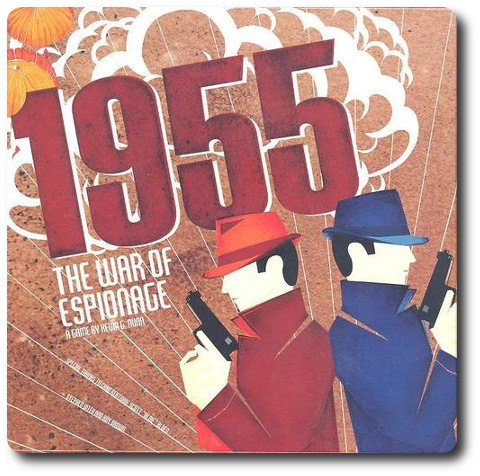
The Basics:
- For ages 8 and up (publisher suggests 14+)
- For 2 players
- Approximately 30 minutes to complete
Geek Skills:
- Counting & Math
- Logical & Critical Decision Making
- Reading
- Strategy & Tactics
- Hand/Resource Management
Learning Curve:
- Child – Easy
- Adult Easy
Theme & Narrative:
- Covert fun for everyone
Endorsements:
- Gamer Geek mixed!
- Parent Geek approved!
- Child Geek approved!
Overview
Actor Gary Oldman said, “I’m almost incapable of lying. I’d be a terrible spy.” But lying is not necessary if you are never noticed, let alone caught or questioned. In this game, you will subtly influence different countries as your opponent does the same. You can only focus your attention in so many places and you must do all you can to avoid drawing too much attention to what you are attempting. Remember: if your opponent knows what you are doing, you are doing it wrong.
1955: The War of Espionage, designed by Kevin G. Nunn and published by APE Games, is comprised of 1 game board (double-sided), 54 cards, 2 Spy pawns (1 red, 1 blue), 6 Control markers (4 neutral, 1 red, 1 blue), and 2 Reference cards. The cards and game board are excellent quality, either being made of solid card stock or thick cardboard. Both the pawns and markers are made of wood. The art by Haley Ross is stylized, colorful, and fits the game’s theme perfectly.
Game Set Up
To set up the game, first place the game board in the middle of the playing area. Each player will take 1 side of the game board (the long sides, not the short ends). When I refer to the “player’s side of the board”, I am referring to the long side the player is sitting directly behind and the short end to their immediate right. The game board is double-sided. One side has shorter country tracks than the other. For a shorter game, use the side with the shorter country tracks.
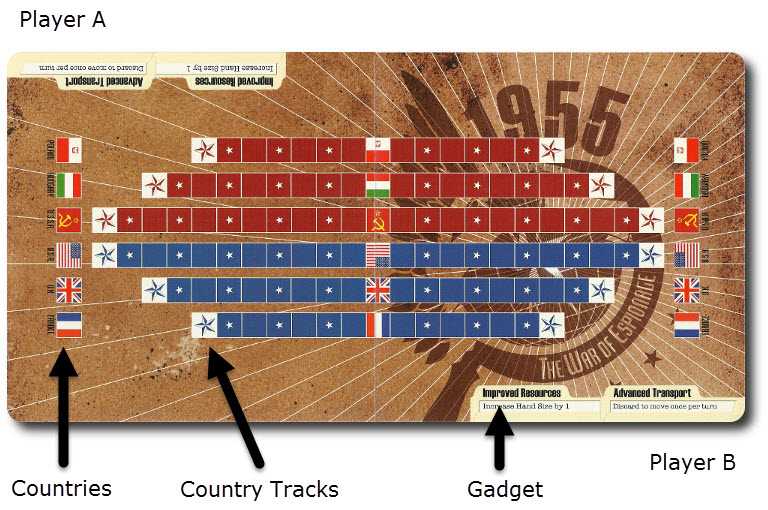
Second, shuffle the cards and deal 5 to each player, face-down. This is the player’s starting hand. Place the remaining cards face-down to one side of the game board. This is the draw deck for the duration of the game. Leave room for a discard pile.
Third, decide who the first player will be and have them review their hand. Based on the cards they have, the first player will now select a country (noted on the game board) and its matching Spy pawn color (red or blue). The Spy pawn is placed on the player’s side (on their right) on the country’s Spy space. The Control marker for the matching color is also placed on the center track space for the selected country. This country is referred to as the player’s “Home Country”.
Fourth, the second player now repeats the same process, but must use a different color and country when selecting their Home Country.
Fifth, the neutral black Control markers are now placed on the remaining center tack spaces for the countries not selected by the players.
Sixth, advance the Control marker for each player’s Home Country toward’s the player’s side (to the player’s right).
That’s it for game set up. First player begins with their opening turn.
The Opening Turn
The first player takes a modified turn when the game begins. The turn is summarized here with additional details found later in this review.
- Play 1 card
- Refill hand
- Move Spy pawn
Game play now continues using standard turns.
Spy Wars
1955: The War of Espionage is played in rounds and turns with no set number of rounds or turns per game. A player’s turn is summarized here. If the player is not holding any cards, step 1 and 2 are skipped. I will be leaving much of the subtle detail out regarding cards, card use, and the combos available to the player. While the game’s rule book is not long or complicated, the game can only be truly understood after it’s played. This is due to the many different ways the cards can be used to influence the game.
Step 1: Play 1 Card
From the player’s hand, 1 or more cards are selected and played face-up in front of them, resolved, and then discarded. There are only 2 card types. These are Country and Mercenary cards.
Country Cards
Country cards can be played 2 different ways. Either for its special action or for its influence. Special actions are described on the card’s face. If the Country card is played for its special action, it’s read out loud, resolved, and then discarded. When playing a Country card for its special action, the card’s country, flag, and number are ignored.
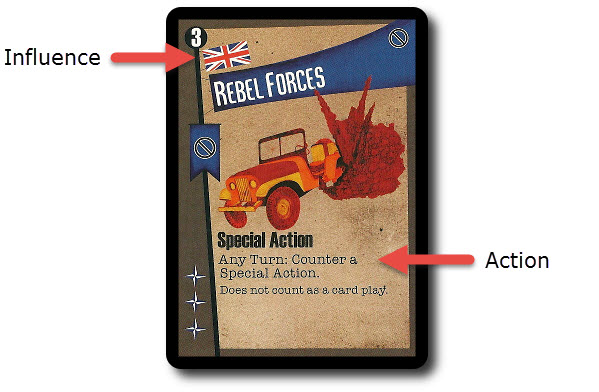
Some Country cards can be played out of turn if the special action is used. The Country card will have the keywords “Any Turn” or “Opponent’s Turn” noted on the card. The player is welcome to play the Country card at the time indicated, but each player can only play 2 cards per round. If a card is played during an opponent’s turn, it counts as 1 of the 2 possible cards the player can play. They will have to wait until the end of the round and their next turn to be able to play 2 cards again.
There are a few “special” Country action cards referred to as “Gadgets”. These are played as normal, but remain attached to the player’s side of the game board and available until removed during the game. Each player has access to gadgets that improve their hand size by +1 and the ability to move their Spy pawn more than once per turn.
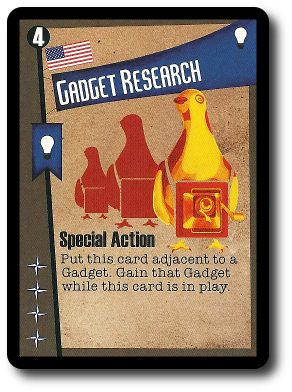
Country cards can also be played to influence the countries on the game board. If the Country card is played for its influence, the special action is ignored.
Country cards can be used to influence a single country that matches the flag on the Country card. The player can also combine 2 Country cards if they share the same flag and match where the player’s Spy pawn is currently located. This counts as a single card play, even though 2 cards are used.
Country cards can be used to influence the country the player’s Spy pawn is located in. If the faction color (red or blue) matches the color of the Country card, the player moves the Control marker a number of spaces equal to the influence number. If the faction colors do not match, the total amount of influence is reduced by -1.
Country cards can also be used to influence the player’s Home Country. Because the player has so much influence and access to their own country’s resources, any Country card can be played regardless of its flag. However, the amount of influence is reduced by -1 if the card’s faction color does not match the player’s faction.
Mercenary Cards
Mercenary cards are guns for hire that can be used to enhance the player’s cards or used individually. They can be used to increase the total amount of influence a Country card has if the player uses their Country card to influence another country. Attaching one or more Mercenary cards in this way does not count towards the player’s 2 card limit.
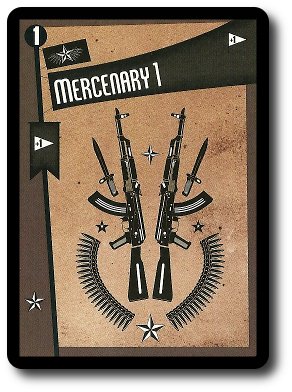
Step 2: Play 1 Card
The second step allows the player to play 1 more cards from their hand. The same rules already summarized apply. However, a player is never able to play anymore than 2 times per round. Playing a card during an opponent’s turn during the same round negates a player’s ability to take this step.
Step 3: Refill Hand
The player now draws back up to 5 cards. It’s possible to be able to draw more cards than 5 during the game by playing Gadget cards. If the draw deck is empty, shuffle the discard pile to create a new draw deck.
Step 4: Move Spy
The player now moves their Spy pawn to any other country they like on their side of the game board. If the player wants to, they can leave the Spy pawn where it’s currently located.
This completes the player’s turn. The next player now takes their turn.
Winning the Hearts and Minds of the Enemy
While special actions are a great way to change player’s fortune in the game or upset the opponent, the real goal is to influence countries. At the end of each country track on the game board is a star. If the player is able to move the Control marker to the star, they have secured the country. It’s possible to block an opponent’s attempt to influence a country, but the country being attacked must either be the player’s Home Country of the player’s Spy pawn must be located in the country. Then the player discards Country and Mercenary card in hopes of having an equal or greater number of influence.
The game ends when a player has any 3 countries secured or the player secures their opponent’s Home Country.
To learn more about 1955:The War of Espionage, visit the game’s web page.
Final Word
The younger Child Geeks had problems with 1955. Each card offers multiple choices in a game that already has multiple areas to focus on. For our younger and inexperienced players, it was overwhelming at first and somewhat stressful. To quote one younger Child Geek, “I don’t know what to do on my turn. Ever! Do I influence a country or take back a country I own? Take an action? It’s never clear.” No, it isn’t. The game does nothing to suggest what a player should do, but if a player is paying attention and has a strategy, the cards will provide tactical choices to achieve goals. This was not lost on the older and more experienced Child Geeks. According to one older Child Geek, “This game didn’t make sense at first, but after a few cards, I know exactly what I am doing. I really like all the choices and never feel like I’m put in a corner.” While I would not say this game has a difficult learning curve, there is most certainly a curve to found. After one game, every Child Geek understood how to play 1955. Not necessarily well, but with enough proficiency to hold their own. When all the votes were in, the game was approved by the Child Geeks, but just barely.
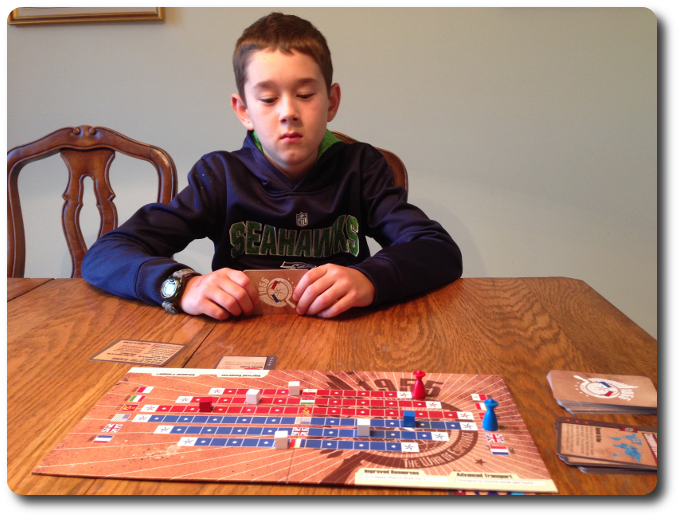
My very first game with my oldest son. He spent most of the time asking, “What? Why?!”
The non-gamer Parent Geeks had the same difficulty as the younger and less experienced Child Geeks. I must again state that I do not believe this game is difficult to learn, but it’s the perceived unlimited number of choices that can cause some to lose focus and be unable to make a decision. Which is not a bad thing, so much as it’s an annoying thing. According to one non-gamer Parent Geek, “What I am getting tripped up by is what to do next. I know I can do many things, but I just don’t know what is the best thing to do first.” Which is part of the challenge. 1955 is a game about subtle movements, acquiring cards, and making surprising plays. All of which are based on cards that can do 2 or more things. The challenge is formulating a plan and executing it. The more experienced Parent Geeks immediately understood this and had a blast with 1955. According to one Parent Geek, “This is now one of my most favorite 2-player games. It’s challenging, rewarding, and best of all, never the same game twice!” Very true and it was fun to see not only the Parent Geeks go against each other, but Parent Geeks versus Child Geeks, too. The game is very well-balanced and victory always went to the better spy. Sometimes that was the Child Geek, believe it not. When all the games were over, the Parent Geeks voted to approve 1955.
The Gamer Geeks understood the game’s complexity and depth right from the start. One aspect of the game they could not avoid discussing was the perceived tug-o-war with the cubes. According to one Gamer Geek, “I like what the cubes are representing in the abstract sense, but I always feel like I just tugging a rope against my opponent. That’s not very entertaining and I lose interest.” Even if the tug-o-war battle is between 6 countries? Oh, sure. Just more wars to tug. Another Gamer Geek said, “I like the game enough to play it again, but I just don’t like it very much. There’s no story here. No spying. No espionage. No war. It’s just me having a bigger number more often and moving the cubes faster than my opponent. I’d play it if someone asked, but I won’t be asking for it.” And yet, there were other Gamer Geeks who liked the game very much. According to one Gamer Geek, “I heard this was like Twilight Struggle, but smaller. Having played both games now, I guess I can see why others might say that, but I don’t believe it. I think 1955 is fun as it is. It’s light, abstract, and a fun 2-player game.” A number of other Gamer Geeks felt the same, finding 1955 to be an interesting and entertaining 2-player game. When the votes were in, the Gamer Geeks game 1955 a mixed approval.
OK, my turn.
I liked 1955: The War of Espionage. No, I don’t think it’s a spy game, even though the game’s theme suggest it. I found it to be too abstract to really feel like I was spying or doing anything other than moving cubes on a track. Which is fine, because it was how I was moving the cubes on the track that was important. This game gives players a lot to consider without swamping them with choices. The biggest obstacle for a player will be determining the best way to act and react to the changes on the game board. Which are, by the way, subtle but always relevant. The smaller country tracks will be hotly contested while the larger tracks will be a slow war. In the middle are the tinny jabs and decoys you set up in hopes your opponent will run towards them, but not always. That’s why I found the game fun. It’s about playing with your opponent’s perception of what is important to you and then doing the complete opposite or something very similar. This is not a game you rush into or can win by strong-arming your opponent. Victory goes to those who can mask their true objective.
There are strategies to explore and tactics to deploy, but not a lot. After about 5 plays of the game, I felt like I had seen or had attempted everything there was to do. I was incorrect, but the number of new ways to approach and tackle the opposition were mostly slight variations of other plays I had already seen. This would suggest that the game’s depth is limited and I believe that to be the case. What depth there is, however, is more than enough to keep 2-players engaged and entertained. If you are looking for a 2-player game where the subtle art of subterfuge is played out in cards, do site down and play 1955: The War of Espionage. While you won’t feel like a spy, you’ll be spying for every opportunity to get the upper hand.
This game was given to Father Geek as a review copy. Father Geek was not paid, bribed, wined, dined, or threatened in vain hopes of influencing this review. Such is the statuesque and legendary integrity of Father Geek.



